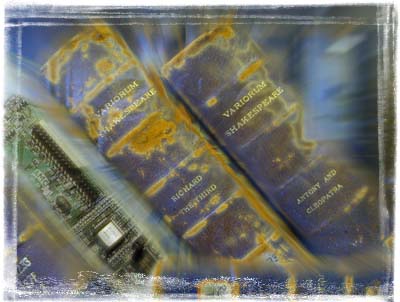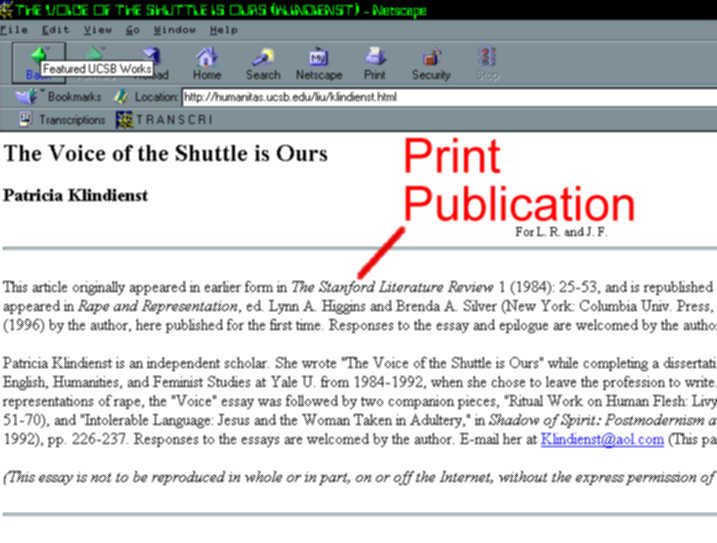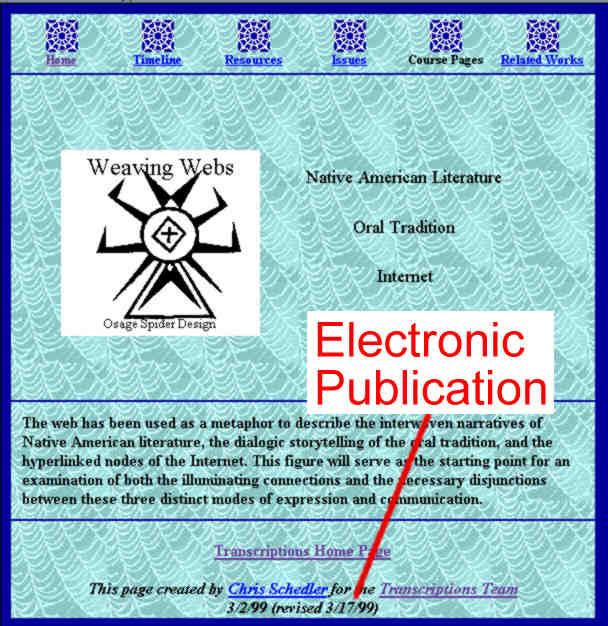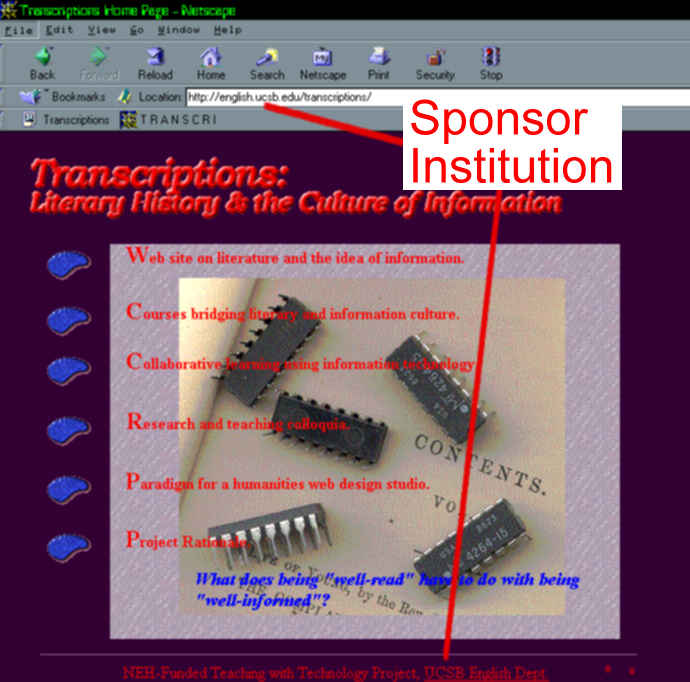|
|
|
|
 Evaluating
and Citing Online Resources
Evaluating
and Citing Online Resources
| |
 his
page provides instructors and students with checklists
for evaluating and citing online resources. It
also includes evaluation exercises and citation
examples to follow, as well as annotated links
to print and online guides for further research. his
page provides instructors and students with checklists
for evaluating and citing online resources. It
also includes evaluation exercises and citation
examples to follow, as well as annotated links
to print and online guides for further research.

|
|
I. Evaluating Online
Resources |
Evaluation Criteria (with Checklist)
The unfiltered and unstable nature of information
found on the Web makes the evaluation of online
resources a necessity. Like print resources, online
resources should be evaluated for the quality
of information they provide (the content) and
the presentation of that information (the form).
The following is a checklist of questions that
can assist you in evaluating both the content
and form of online resources. (Printable
form for checklist) For help filling out the
information at the top of the checklist see finding
citation information.
Citation Information

Content Criteria 
Authority
- What is the authority or expertise of the
author/site creator (what biographical information,
credentials, or affiliations are provided)?
- How official, legitimate, or generally trusted
is the site (as indicated by its sponsoring
organization or any reviews, references, or
works cited you have consulted)?
- What is unique or "cool" about the
site (original work, primary information, or
added value)?
- Alternatively, in what ways does the site
embrace the anonymous and collective nature
of discourse on the Web to question the notions
of authority, legitimacy, or originality?
Integrity
- How accurate is the information on the site
(what sources or links to other sites are provided
that help you validate its information)?
- How current is the information on the site
(as indicated by its creation date, updates,
revisions, or other maintenance information)?
- How durable is the information on the site
(as indicated by archives or a version history)?
- How comprehensive is the information on the
site (as indicated by full text, live links,
scope statement, contents page, or site map)?
- Alternatively, in what ways does the site
embrace the fluid nature of discourse on the
Web to question the notions of accuracy, currency,
durability, or comprehensiveness ?
Objectivity
- What is the purpose of providing the information
on the site (e.g., advocacy, marketing, education,
news, entertainment)?
- Who is the intended audience and how are they
addressed (formally/informally, as consumer/visitor/professional/colleague)?
- What sort of bias if any is evident (as indicated
by the content, tone, author, or organization)?
- Alternatively, in what ways does the site
affirm such other values as the subjective and
personal?
Form Criteria 
Design
- How does the organization of information (by
subject, format, audience) contribute to your
understanding?
- How are different media (text, graphics, video,
audio) integrated to contribute to your understanding?
- How do navigational features (index, links,
map) help you move around and locate information
on the site?
- Alternatively, if the design distracts or
detracts from your understanding, does it do
so to challenge the notions of clear information,
transparent communication, or complete understanding?
Usability
- How do user features (search engines, "help"
systems, interactivity) aid you in finding and
understanding information on the site?
- How do alternative access features (for text-only
and heritage browsers, for sight or hearing
impaired) aid different users?
- How well does the resource address your particular
information needs?
Evaluation Exercises
Grassian, Ester and D. Zwemer. Hoax?
Scholarly Research? Personal Opinion? You Decide!
10 June 1999. College Library, U of California,
Los Angeles. 4 August 1999 <http://www.library.ucla.edu/libraries/college/help/hoax/>.
Evaluate websites based on Authority & Accuracy;
Advocacy & Objectivity; and Currency &
Coverage.
Henderson, John. ICYouSee:
T is for Thinking. 22 July 1999. Ithaca C.
Library. 4 August 1999 <http://www.ithaca.edu/library/Training/hott.html>.
Advice on evaluating websites and a homework assignment
to analyze four sites based on Authority, Content,
Design, and Value.
Holmes, Katharine. Evaluating
Web Sites. 28 April 1999. Ludcke Library,
Lesley C. 4 August 1999. <http://www.lesley.edu/library/guides/research/evaluating_web.html>.
Evaluate good and bad websites based on APACAROC:
Accessibility, Purpose, Appropriateness, Currency,
Authority, Responsibility, Objectivity, and Clarity.
Internet
Detective. Institute for Learning and Research
Technology, U. Bristol. 5 August 1999 <http://sosig.ac.uk/desire/internet-detective.html>.
Free online tutorial requiring registration helps
users evaluate online resources based on Content,
Form, and Process.
Evaluation Guides
Alexander, Jan and Marsha Ann Tate.
Evaluating
Web Resources. 24 June 1999. Widener U.
16 July 1999 <http://www2.widener.edu/Wolfgram-Memorial-Library/webevaluation/webeval.htm>.
Teaching modules show users how to evaluate the
informational content of Web resources. Criteria
for evaluation include Authority, Accuracy, Objectivity,
Currency, and Coverage.
Alexander, Jan and Marsha Ann Tate.
Web
Wisdom: How to Evaluate and Create Information
Quality on the Web. Mahwah, NJ: Lawrence
Erlbaum Associates, 1999. "This book addresses
Web evaluation issues from two perspectives: from
the point of view of the Web user and from the
point of view of the Web page author. It provides
easy-to-use checklists for evaluating existing
Web pages to determine whether the information
contained in them is likely to be of value or
not."
Grassian, Esther. Thinking
Critically about World Wide Web Resources.
Oct. 1998. College Library, U of California, Los
Angeles. 16 July 1999 <http://www.library.ucla.edu/libraries/college/help/critical/>.
Provides evaluation guide of questions to ask
when judging the value and reliabilty of Web resources.
Topics include Content & Evaluation, Source
& Date, and Structure.
Harris, Robert. Evaluating
Internet Research Sources. 17 November
1997. Southern California C. 16 July 1999 <http://www.virtualsalt.com/evalu8it.htm>.
Well-organized article on selecting and evaluating
Internet research sources. Offers the CARS (Credibility,
Accuracy, Reasonableness, Support) checklist for
information quality.
Meyer, Ellen. Evaluating
the Quality of World Wide Web Resources. 1
July 1999. Valparaiso U. 4 August 1999 <http://www.valpo.edu/library/evaluation.html>.
Discussion of ways to find and evaluate information
on the Web. Evaluation criteria include Authorship,
Publisher, Point of View, Content, Coverage/Scope,
Currency, and Workability.
Rettig, James. "Beyond
"Cool": Analog Models for Reviewing Digital Resources."
ONLINE Sept. 1996. 16 July 1999 <http://www.onlinemag.net/SeptOL/rettig9.html>.
Advocates adapting criteria developed for evaluation
of print materials to evaluation of Web resources.
See appendix for "Comparative Criteria for
Reviewing Reference Books and Web Sites."
Ten
C's For Evaluating Internet Sources. 11
Nov. 1998. McIntyre Library, U of Wisconsin, Eau
Claire. 16 July 1999 <http://www.uwec.edu/Admin/Library/Guides/tencs.html>.
The ten C's are: Content, Credibility, Critical
Thinking, Copyright, Citation, Continuity, Censorship,
Connectivity, Comparability, and Context.
Walker, Janice. "Evaluating
Your Sources." The English Pages Citation
Guide. Addison Wesley Longman. 13 July 1999
<http://www.awl.com/englishpages/citation_walker_eval.htm>.
Guide to evaluating electronic resources based
on Authority, Timeliness, Relevance, Author's
Purpose, and Audience.
Wilkinson, Gene, Kevin Oliver, and
Lisa Bennett. Internet
Information Evaluation Form. 1998. U of
Georgia. 16 July 1999. <http://www.edtech.vt.edu/edtech/kmoliver/webeval/form2.pdf>.
Provides a downloadable evaluation form in PDF
format developed from scholarly project that identified
indicators of information and web site quality,
classified them within eleven criterion categories,
and rated them in terms of importance.
|
|
Citing Online Resources |
Citation Checklist
The citation style recommended by the Modern
Language Association of America (MLA) has been
adopted by most literary scholars and journals
for documenting sources in academic writing and
publication. The style was developed with print
resources in mind but has been adapted for online
resources. Because of the changing nature of the
technology, the style is continually evolving
to account for the variety of electronic resources
and modes of accessing electronic information.
The following checklist has been adapted from
the online MLA style guide. A variant style has
been recommended by the Columbia Guide to Online
Style (CGOS). See the print
and online guides below for the authorized
style guides.
Works
Cited 
In MLA style, every source you cite must appear
in a "Works Cited" list at the end of
your paper. For all electronic resources included
on your "Works Cited" list, supply those
items from the checklist below which are relevant
and available. The examples
that follow show how these elements are incorporated
into specific citations.
- Name of author, editor,
compiler. Last name first for alphabetizing.
Followed by abbreviated title, such as "ed.",
if appropriate.
- Title of story, article,
or webpage within book, website, database, or
online journal; or subject line of an e-mail
message or posting to a discussion list (followed
by "E-mail to author [or recipient's name]"
or "Online posting"). Title or subject
line in quotation marks.
- For previously published
print texts available online: title of book
or journal (underlined); name of editor or compiler
of the text (if relevant and if not cited earlier),
preceded by the appropriate abbreviation, such
as "Ed."; publication information
for print version.
- Title of website, database,
or online journal (underlined). For a website
with no title use a description such as "Home
page."
- Name of the editor or
compiler of website, database, or online periodical
(if relevant and if not cited earlier), preceded
by the appropriate abbreviation, such as "Ed."
- Version number of the
source (if not part of the title) or, for an
online journal, the volume number, issue number,
or other identifying number.
- Date of electronic
publication, of the latest update, or of posting.
- For a work from
a subscription service: the name of the service;
name, location (city, state) of subscribing
library (if appropriate).
- For a posting to a discussion
list or forum: the name of the list or forum.
- The number range or
total number of pages, paragraphs, or other
sections, if they are numbered.
- Name of any sponsor
institution or organization associated with
the source.
- Date when you accessed
the source.
- Electronic address, or URL,
of the source; e-mail address of discussion
list or forum moderator; or keyword assigned
by subscription service. Electronic addresses
in angle brackets.
In-Text
Citations 
In MLA style, parenthetical citations included
in the text supply information that directs the
reader to the correct source in the "Works
Cited" list. For print resources this usually
includes the author's last name and the page number
of the citation (Klindienst 25). Since electronic
resources are not normally paginated, include
only the author's last name (Schedler) or the
title of the resource (Transcriptions)
for works without a documented author.
For sources that include fixed page or section
numbers, such as paragraphs, include the relevant
numbers in your citation (Harpold, pars. 19-21).
You need not count paragraphs if numbers are not
included in the document, nor should you cite
pages from a printout of the electronic information.
Finding
Citation Information 
Print resources normally offer citation
information up front: on the title page of the
book or journal. Such information may be more
difficult to find within electronic resources,
which are far from standardized in the amount
and placement of the information they provide.
The author's name may be at the top or bottom
of the electronic document. Look for such tags
as "Created by," "Maintained by,"
"E-mail to" or "Send comments to."

Titles usually appear at the top of the document.
There should also be a title in the head of the
document, which appears at the top of the browser
window. If the two titles differ, choose the title
which best describes the document. If no title
appears, supply an appropriate description.

Previous publication information for print versions
of an electronic document usually appears at the
top or bottom of the document.

The date of electronic publication or last update
may appear at the top or bottom of the document.
Look for such tags as "Last modified"
or "Last revised." Remember that the
publication date is usually not the same as the
date you accessed the document. You need to provide
both dates whenever possible.

The name of the sponsoring institution or organization
may sometimes be identified from the first part
of the electronic address (the domain name). For
example, university domains end in ".edu"
(ucsb.edu), organization domains end in ".org"
(mla.org), company domains end in ".com"
(aol.com), and government domains end in ".gov"
(doc.gov). If you can't decipher the name from
the address, try truncating the address to the
domain name (http://www.mla.org/) to get to the
institution's homepage; or look for links to the
sponsoring institution at the bottom of the document
or the homepage of the website.

Citation
Examples
The following are MLA style citation examples
for some common online resources as they would
appear in a "Works Cited" list. Each
entry includes a specific citation example and
list of the general elements in that citation,
as described in the checklist
above.
Website

Webpage

Text
Previously Published in Print 
Article
in Online Journal 
Work
from Subscription Service 
Posting
to Discussion List 
E-Mail
Message 
Citation
Guides
Crouse, Maurice. Citing
Electronic Information in History Papers.
6 May 1999. U of Memphis. 8 July 1999 <http://www.people.memphis.edu/~mcrouse/elcite.html>.
Modifies Li and Crane's citation styles for electronic
information to confrom with Kate L. Turabian's
A Manual for Writers of Term Papers, Theses,
and Dissertations. Offers a useful guide to
"Finding
and Using the Information for Citations."
Documenting
Sources from the World Wide Web. 9 July 1998.
Modern Language Association of America. 3 July
1999. Available on MLA site <http://www.mla.org>.
A FAQ derived from the MLA style guides (see below);
includes sample entries for some common kinds
of Web sources.
Gibaldi, Joseph. MLA Handbook for Writers
of Research Papers. 5th ed. New York: Modern
Language Association of America, 1999. MLA style
guide for high school and undergraduate college
students. Includes section on citing electronic
publications.
-----. MLA Style Manual and Guide to Scholarly
Publishing. 2d ed. New York: Modern Language
Association of America, 1998. MLA style guide
for graduate students, scholars, and professional
writers. Includes updated guidelines on citing
electronic works.
Guffey, Mary Ellen. "MLA
Style Electronic Formats." Business
Communication Quarterly March 1997: 59-76.
20 Aug. 1998. 8 July 1999 <http://www.westwords.com/guffey/mla.html>.
Concise guide with examples on MLA style formats
for citing a variety of electronic documents.
Harnack, Andrew and Eugene Kleppinger. Online!
A Reference Guide to Using Internet Sources.
New York: St. Martin's Press, 1997. Contains chapters
on locating Internet sources, accessing information,
evaluating and citing electronic resources, and
publishing texts on the Internet. Chapter on Using
MLA Style to Cite and Document Sources is
available online.
-----. Beyond
the MLA Handbook: Documenting Electronic Sources
on the Internet. 10 June 1996. Eastern
Kentucky U. 8 July 1999 <http://english.ttu.edu/kairos/1.2/inbox/mla_archive.html>.
Response to Janice Walker's MLA-Style Citations
of Electronic Sources (first version of CGOS-Humanities
style; see <http://www.columbia.edu/cu/cup/cgos/idx_basic.html>).
Recommends additions and emendations to Walker's
models that help eliminate ambiguities and provides
a revised style
sheet of formats.
Hoemann, George H. Electronic
Style . . . the Final Frontier. 14 Sept.
1998. U of Tennessee, Knoxville. 8 July 1999.
<http://web.utk.edu/~hoemann/style.html>.
Discussion of the problems and elements of citation
for electronic style. His response to the question
"Why
Cite?" may be useful for students.
ISO
690-2: Bibliographic References to Electronic
Documents. 10 Feb. 1999. International Organization
for Standardization. 4 August 1999 <http://www.nlc-bnc.ca/iso/tc46sc9/standard/690-2e.htm>.
Specifies international standards for data elements
and their prescribed order in bibliographic references
to electronic documents.
Li, Xia and Nancy B. Crane. Electronic Styles:
A Handbook for Citing Electronic Information.
Revised Ed. Medford, N.J.: Information Today,
1996.
Longman
English Pages Online Citation Guide. Addison
Wesley Longman. 3 July 1999 <http://www.awl.com/englishpages/citation.htm>.
Includes links to J.D. Lester's Citing
Cyberspace and Janice Walker's The
English Pages Citation Guide. Both offer guidelines
for finding, evaluating, and citing online resources
using MLA style (Lester) or Columbia Online style
(Walker). Also includes simulated search activities
for students.
Taylor, Todd. Basic
CGOS Style. 1 Sept. 1998. Columbia UP.
3 July 1999 <http://www.columbia.edu/cu/cup/cgos/idx_basic.html>.
Overview of The Columbia Guide to Online Style
for citing electronically-accessed sources in
both humanities and scientific styles. Includes
elements of the citation, in-text documentation,
and bibliographic formats for a range of sources
grouped by method of access or protocol.
Walker, Janice R. and Todd Taylor. The
Columbia Guide to Online Style. New York:
Columbia UP, 1998. Provides rules for citation
and complete guidelines for formatting documents
for online publication and for electronically
preparing texts for print publication.
|
|
|
|
|
|
|